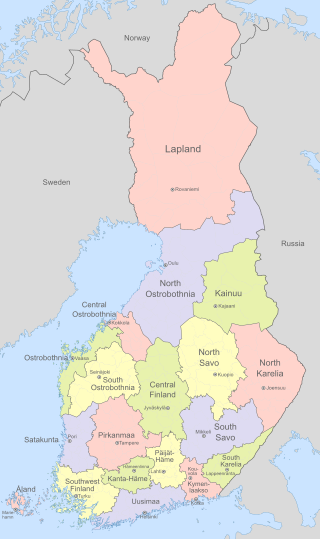Top Qs
Timeline
Chat
Perspective
Regions of Finland
From Wikipedia, the free encyclopedia
Remove ads
Finland is divided into 19 regions (Finnish: maakunta; Swedish: landskap)[a] which are governed by regional councils that serve as forums of cooperation for the municipalities of each region. The councils are composed of delegates from the municipal councils. The main tasks of regional councils are regional planning, the development of enterprises, and education. Between 2004 and 2012, the regional council of Kainuu was elected via popular elections as part of an experimental regional administration.[2]
In 2022, new Wellbeing services counties were established as part of a health care and social services reform. The wellbeing services counties follow the regional borders, and are governed by directly elected county councils.[3]
Remove ads
Åland
One region, Åland, has a special status and has a much higher degree of autonomy than the others, with its own Parliament and local laws, due to its unique history and the fact that the overwhelming majority of its people are Finland Swedes. The sole language of Åland is Swedish/Finland Swedish, unlike the rest of the country where Finnish and Swedish share official status. It has its own elected head of government who carries the title of Premier and heads the Lantråd, the regional executive. Most powers that would be exercised by the Government of Finland on the mainland are instead exercised by Åland-specific authorities which execute independent policy in most areas. The Åland islanders elect a single representative to the national legislature, while the Government of Finland appoints a Governor to represent the national government on Åland. Åland is a demilitarized zone and Åland islanders are exempt from conscription.
Remove ads
Representation of the state
In addition to inter-municipal cooperation, which is the responsibility of regional councils, there are 15 Centres for Economic Development, Transport and the Environment (Finnish: elinkeino-, liikenne- ja ympäristökeskus, abbreviated ely-keskus), which are responsible for the local administration of labour, agriculture, fisheries, forestry and entrepreneurial affairs. They are each responsible for one or more of regions of Finland, and include offices of the Ministries of Employment and the Economy, Transport and Communications and Environment. The Finnish Defence Forces regional offices are responsible for the regional defence preparations and for the administration of conscription within the region.
Remove ads
List of regions
Summarize
Perspective
Former region

Regional border changes
Border changes between the regions:[8]
1997
- Kiikoinen transferred from Pirkanmaa to Satakunta.
2001
2002
- Kangaslampi transferred from South Savo to North Savo.
2005
- Punkalaidun transferred from Satakunta to Pirkanmaa.
2007
- Längelmäki merged with Orivesi in Pirkanmaa and Jämsä in Central Finland.
2010
- Himanka transferred from Central Ostrobothnia to North Ostrobothnia by merging with Kalajoki.
- Part of Ruotsinpyhtää in Eastern Uusimaa transferred to Pyhtää in Kymenlaakso.
2013
- Kiikoinen transferred from Satakunta to Pirkanmaa by merging with Sastamala.
- Suomenniemi transferred from South Karelia to South Savo by merging with Mikkeli.
2016
- Vaala transferred from Kainuu to North Ostrobothnia.
2021
Remove ads
See also
- Municipalities of Lapland
- Regions of Northern Finland
- Regions of Eastern Finland
- Regions of Western and Central Finland
- Regions of South-Western Finland
- Regions of Southern Finland
- Municipalities of Åland
- County Councils of Sweden
- Household pennants of Finland
- ISO 3166-2:FI
- Regional State Administrative Agency
- List of Finnish regions by GDP
Notes
- Northern Sami: eanangoddi, Inari Sami: eennâmkodde, and Skolt Sami: mäddkåʹdd.[1]
References
External links
Wikiwand - on
Seamless Wikipedia browsing. On steroids.
Remove ads


